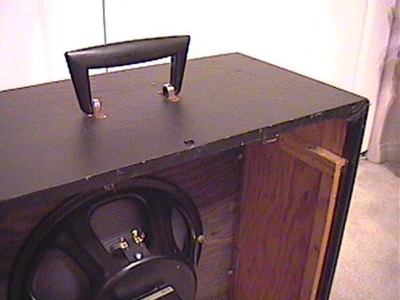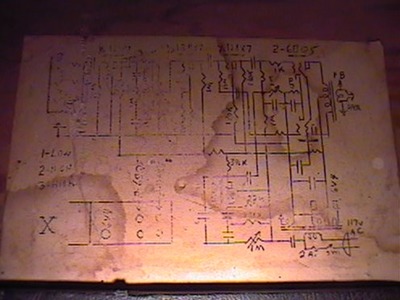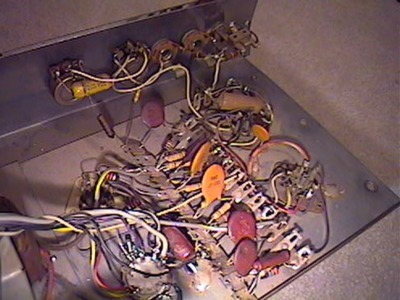The Gregory Mark X Tube Guitar Amp
By Paul Marossy
Last updated 5/16/05
I bought this amp off of ebay because I was intrigued
by it and had a hunch that it would sound pretty good, and it does. I have never even heard of Gregory Amps before, but there are a
few examples of them out there. Before this page was created, there was nothing on the web about this particular amp other than one user review at Harmony
Central. They were apparently made in the United States near Elizabeth, NJ sometime in the mid-60s or so.
Being an inexpensive amp, I'm sure the circuit used is a copy of some other popular amp. From what I can tell, it is
similar to a Vox Pacemaker, the main difference being the tone control scheme. The Gregory Mark X is an AB push-pull amplifier producing probably 10-12 watts of output power.
It utilizes a split load phase inverter and a phase shift oscillator which modulates
the power tube bias to acheive the tremolo effect. You can actually see this happening in the power tube
while the tremolo is engaged, and it's kind of cool to watch it pulsating. The tone control has a pretty wide range and will give you a pretty
dark tone to a pretty bright tone. Gain is pretty much controlled by the volume control. I would say this amp sounds similar to my Matchless
Spitfire clone, but with tremolo.

|
This is the front of the amp. The grille cloth is kind of funky - almost a burlap kind of material with some kind of silkscreening applied to it and glued to the speaker baffle. Probably considered cool in the mid-60s, which is when I estimate this amp was made. The "tolex" is some paper thin kind of vinyl covering glued to the enclosure. Overall weight of the amp is about 30 lbs. and the overall size of the amp is 19"x19"x9.5" deep. |

|
Controls on the left side of the face are volume and tone. There is also three input jacks on this amp. Kind of unusual as most amps only have two. |

|
Controls on the right side of the face are tremolo speed and tremolo intensity. There is also a power switch, a footswitch jack for the tremolo section, a fuse holder and a pilot light that has an interesting feature - you can adjust its brightness by turning the housing! Very unusual. Notice the lack of a standby switch. |

|
This is the nameplate in the lower right hand corner. It appears to be silkscreened onto a piece of aluminum and glued to the speaker baffle. |

|
Even the carrying handle is unusual! |

|
This is a view of the back of the amp. There was apparently a back cover for it at one time. I am going to make a ventilated replacement back when I replace the "tolex". The original speaker has been replaced with a good sounding speaker of unknown origin. It was allegedly pulled from a Matchless speaker cabinet, but I have my doubts. Anyhow, the bottom line is that it sounds very good. A few years after picked up the amp, I did a little research and found out that it is an Eminence OEM Alnico speaker rated for 20 watts. (Thank you Anthony at Eminence!) |

|
This a view of the chassis from the back. Not the full surround type chassis that you would find on modern amps. Shielding is pretty lame, another thing I will improve in my "restoration". The power cord is not grounded. I will also change that to a grounded power cable in my restoration process. |

|
Although the enclosure is constructed of 1/2" and 3/8" 5-ply plywood, it is amazingly sturdy thanks to finger jointed edges. This also makes the amp very light, and gives the impression that the amp is cheap (it is!) and that it's not road worthy. It is true that it's not built like a Marshall speaker cab, but it is a lot stronger than it leads one to believe. I wouldn't be afraid to take it to a gig, but I am also very careful with all of my equipment. |

|
One thing that surprised me was that there was a schematic attached to the bottom of the enclosure. Unfortunately, it has suffered water damage and it largely illegible now. I derived the schematic linked at the bottom of this page from this schematic and as-builting the amp. |

|
Here is the bottom of the chassis. One thing that struck me is that it is made of three pieces riveted together! In spite of that, it gets the job done and is actually pretty sturdy when installed in the enclosure. Tube compliment is a 6CA4/EZ81 dual anode rectifier tube, a pair of EL84/6BQ5 power tubes and a pair of 12AX7/ECC83 preamp tubes. It appears that a 6V4 rectifier tube was originally used in the amp. A 6AC4 rectifier tube is a direct replacement and it draws more heater current than the 6V4, but not enough to cause any problems. The power transformer is made by Philco and has the markings "32-10006-1" and "138309E" on it. One can determine the approximate manufacturing date of the amp from these sorts of codes. My research tells me that this transformer was made in 1963. |

| Here's the inside of the chassis. Not the best wiring job I have seen, but it's suprisingly quiet in spite of the rather crude wiring job - until you turn the volume up towards max. All of the wires are solid core. Notice the internally mounted output transformer. The only markings on the output transformer are "12581-1" and "549902R". My research tells me that the output transformer was manufactured by Midwest Coil & Transformer in 1959. There does seem to be a considerable amount of time between when the output transformer was manufactured and when the amp was manufactured, but judging by the way it's constructed, a manufacture date of 1963 based on the codes on the power transformer seems reasonable. |
 |
This is a little closer view of the backs of the pilot light, fuse holder, power switch and tremolo control pots. |
 |
This a closer view of the other half of the chassis. Most of the circuitry is right in this area. Resistors seem to be a mixture of carbon comp and metal film. Coupling caps all appear to be ceramic and there are also some of those old "barrel" type ceramic caps like you might find in an old Tektronix oscilloscope. |
 |
Different view of the same area. All wiring is point-to-point using terminal strips. The volume pot has the markings "304-6508" on it. This would indicate that it is a Stackpole pot that was manufactured in 1965. Since this is the component with the latest date on it, I would estimate that the amp was manufactured in 1965/66. |
 |
This is a closer view of the tremolo control pots. A pair of dual ganged pots. The markings on the pots are "140-6333" and "CM31683". These markings indicate that they are Clarostat pots that were manufactured in 1963. |
Overall, I don't feel that this a bad amp in terms of design. It's just built very cheaply. The tone is actually decent and it is pretty warm sounding. If you like that tremolo sound that you can hear on some Bill Frisell recordings, this amp will get you there. It's also fairly loud for the wattage as well. For the price, it's not a bad amp, especially for a beginner or someone who is looking for the uncommon tube amp.